Affiliate links on Android Authority may earn us a commission. Learn more.
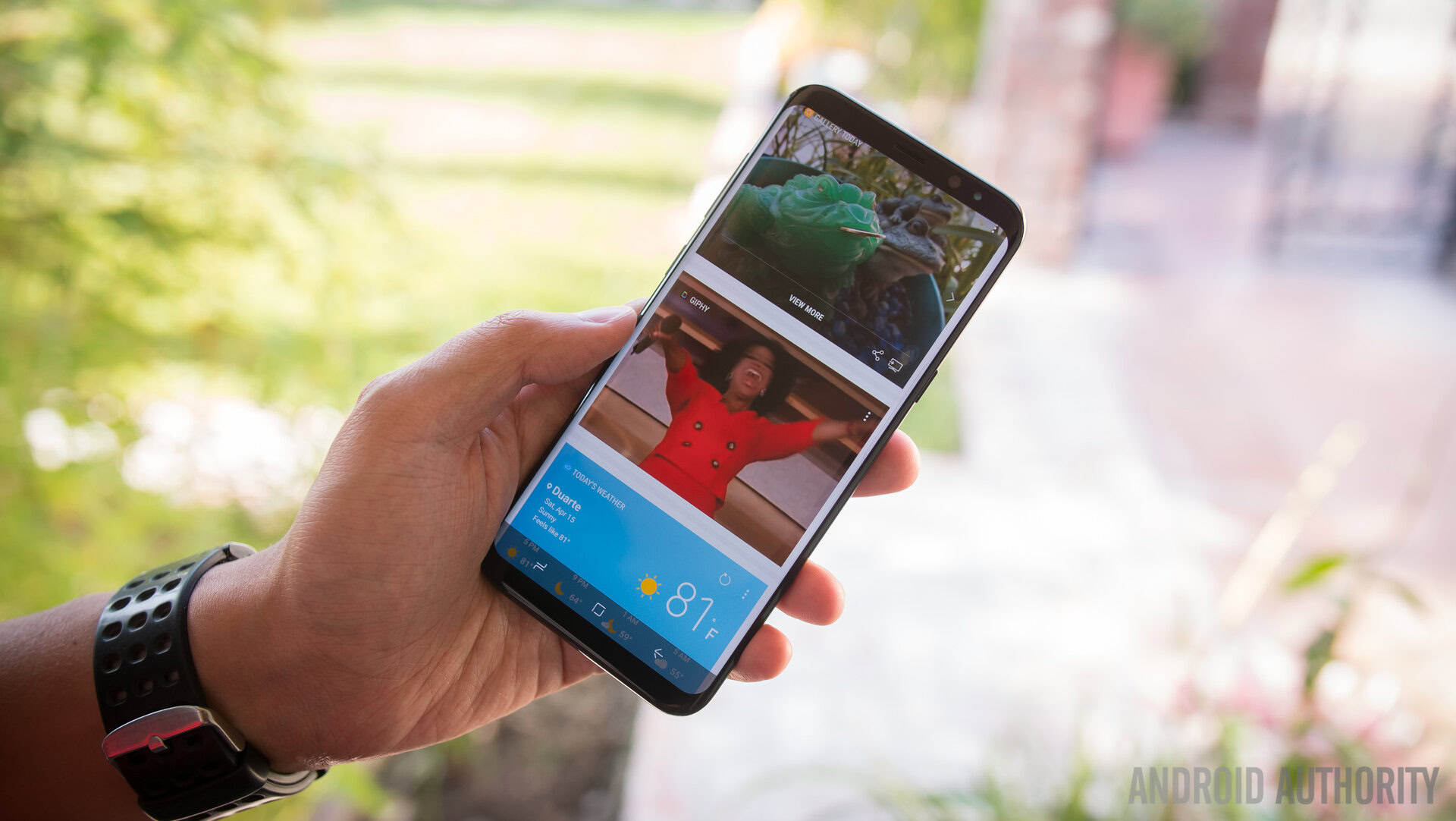
Samsung Galaxy S8
What we like
What we don't like
Our scores
Samsung Galaxy S8
Update (2/16): With the Samsung Galaxy S9 just around the corner, we thought this would be a fun time to take a look back at our review for the current S8 family. After all, soon this will be a highly discounted model making it a potential purchase for those looking for a great phone but wishing to same some serious cash in the process.
The Galaxy S7 and Galaxy S7 Edge might have been two of the best phones of 2017, but the well-documented issues faced by the Galaxy Note 7 have cast a shadow over Samsung’s mobile efforts. From two fantastic smartphones to a phone that would have been near-perfect had it not spontaneously caught fire, 2016 was a year to remember and forget for Samsung, and its next flagship was always going to come under intense scrutiny.
Don’t miss: Where to buy the Galaxy S8 and S8 Plus
Ahead of its Unpacked event last month, Samsung flooded media with advertising designed to begin the painstaking process of rebuilding the customer faith that took years to accumulate. Then came the Galaxy S8 and Galaxy S8 Plus, two phones that push the boundaries further than ever before, but do they offer enough?
In previous years, Samsung’s Galaxy S flagship(s) would almost certainly be the best phones of the year, but this year LG, HUAWEI, and Sony have all bought their very best to the market, and Samsung’s issues have presented a rare chink in its armor. Do the Galaxy S8 and Galaxy S8 Plus continue past trends of being the best Android smartphones? Find out in our Samsung Galaxy S8 review!
To bring our readers, and viewers, the most comprehensive review experience possible, the Galaxy S8 and Galaxy S8 Plus were reviewed by two different members of Android Authority. While Joshua Vergara put together the video linked above, I, Nirave Gondhia, put together the in-depth written Samsung Galaxy S8 review encompassing both of our opinions to provide the definitive Android Authority view on Samsung's latest flagship.
We have both been testing international versions of the Galaxy S8 with model number G950F on build number ending 1AQC9 running Android 7.0.1, with the March 2017 security updates. Our usage with the Galaxy S8 Plus (model number G955U on build number ending 1AQD9) was limited to only a few days and we’ll be following up this review with additional testing around the battery, display, and performance in the coming days.
Design
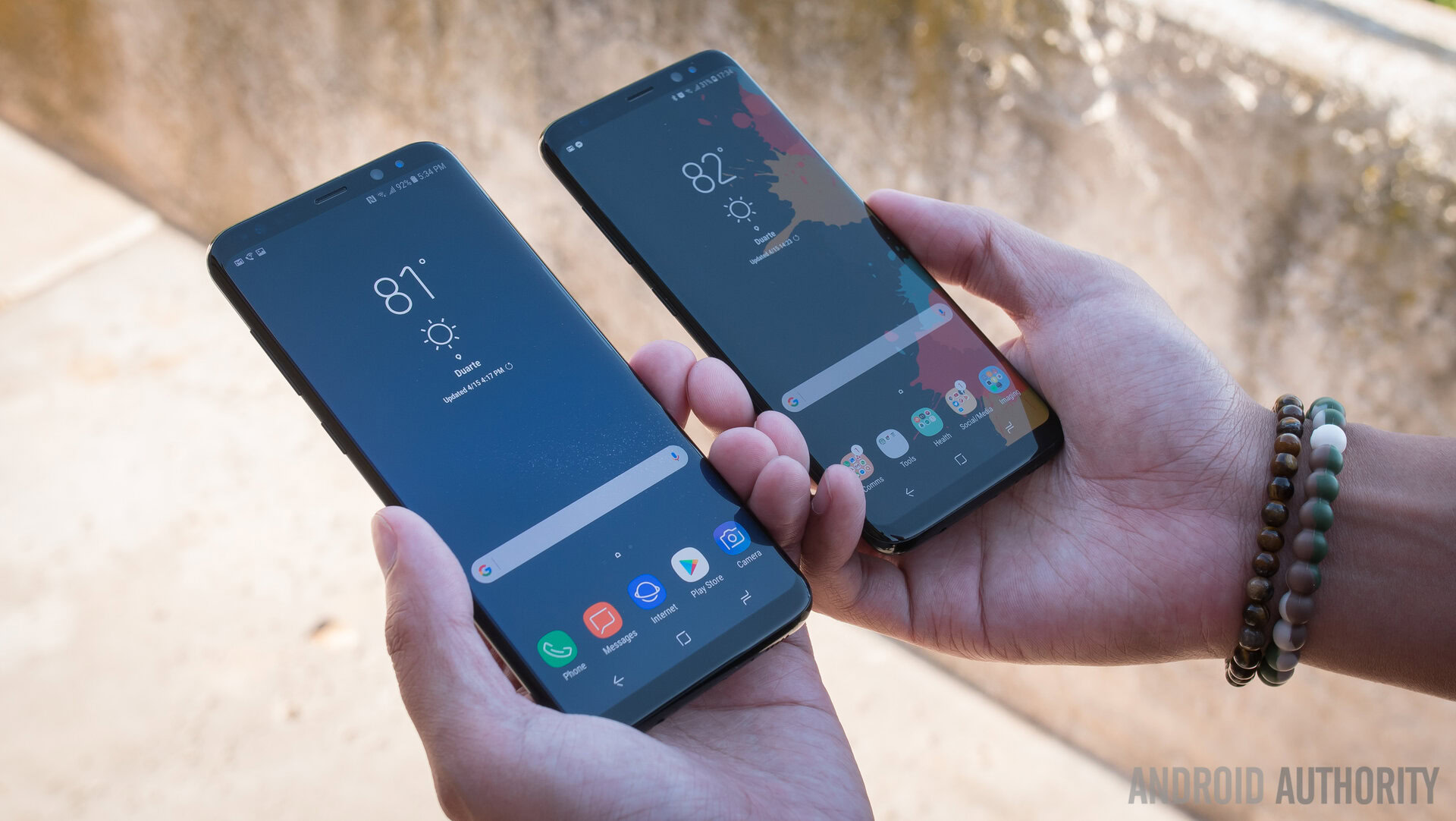
Over the past few years, Samsung has transitioned away from its plastic past to a refinement of its glass and metal build, and the Galaxy S8 presents the future of this design language. There’s two sizes to the Galaxy S8 but neither comes with an Edge moniker, with Samsung calling its taller curved screens the Infinity Display. The focus with this year’s phones isn’t the curved display however, but more so how Samsung has managed to squeeze so much screen real estate into the Galaxy S8 and Galaxy S8 Plus. Thanks to the switch to a 18.5:9 format and the removal of the home button and Samsung branding on the front, we have phones that feel a lot smaller than they should.

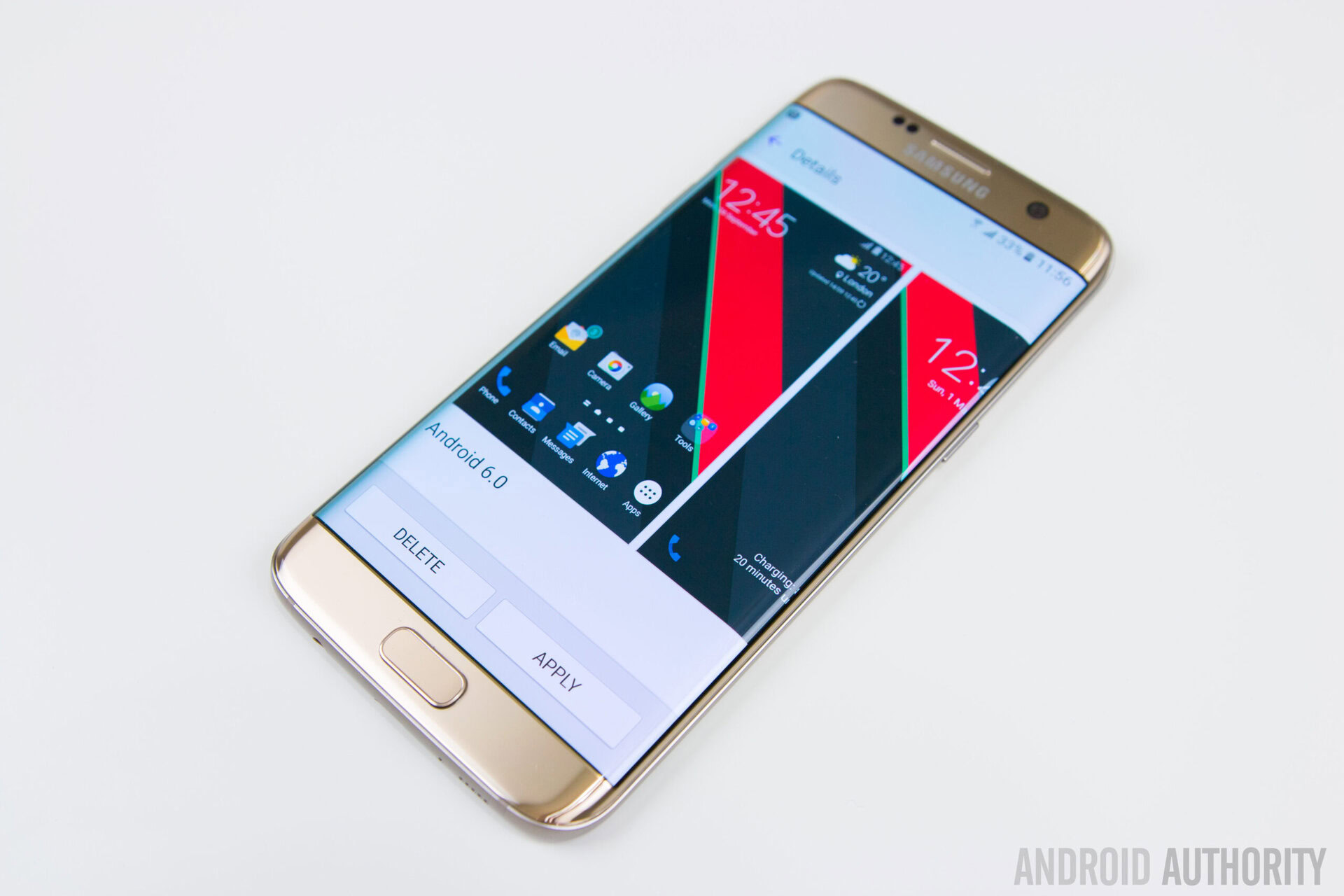
We have phones that feel a lot smaller than they should
Think back to previous phones with displays of 5.5-inches or larger and they felt great at the time, but even the Galaxy Note 7 feels positively large compared to Samsung’s latest flagships. The 5.8-inch display inside the Galaxy S8 comes inside a body that’s slightly taller but narrower than the Galaxy S7 (148.9 x 68.1 mm vs 142.4 x 69.6 mm). Similarly, the Galaxy S8 Plus is a little taller and wider than the Galaxy S7 Edge (159.5 x 73.4 mm vs 150.9 x 72.6 mm) despite a screen that’s 0.7 inches smaller.
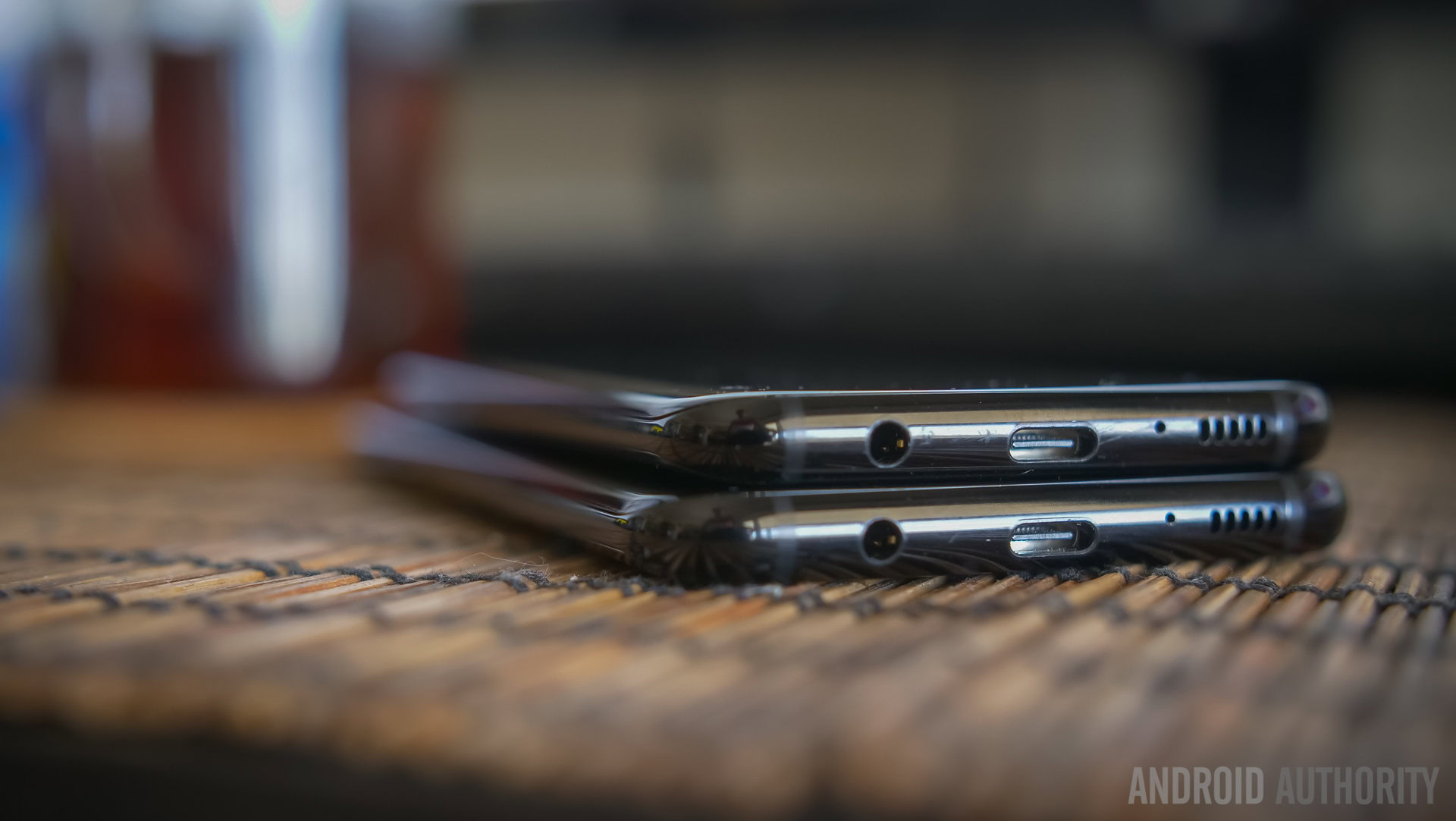
Both phones are a little thicker at 8 mm and 8.1 mm respectively, but the difference is negligible compared to the much better in-hand experience. The added screen real estate sees a bump in the weight as well, at 155 grams and 173 grams respectively, but this helps the Galaxy S8 feel more premium in the hand.
Moving around the phone, the volume keys are on the left and the power button on the right, as with previous Samsung phones. The left sees the addition of a dedicated shortcut for Bixby and Bixby Home, Samsung’s new AI assistant, which we’ll touch on later. Up top is the SIM card tray while on the bottom, you’ve got the headphone jack, USB Type-C port, and single bottom-firing speaker.
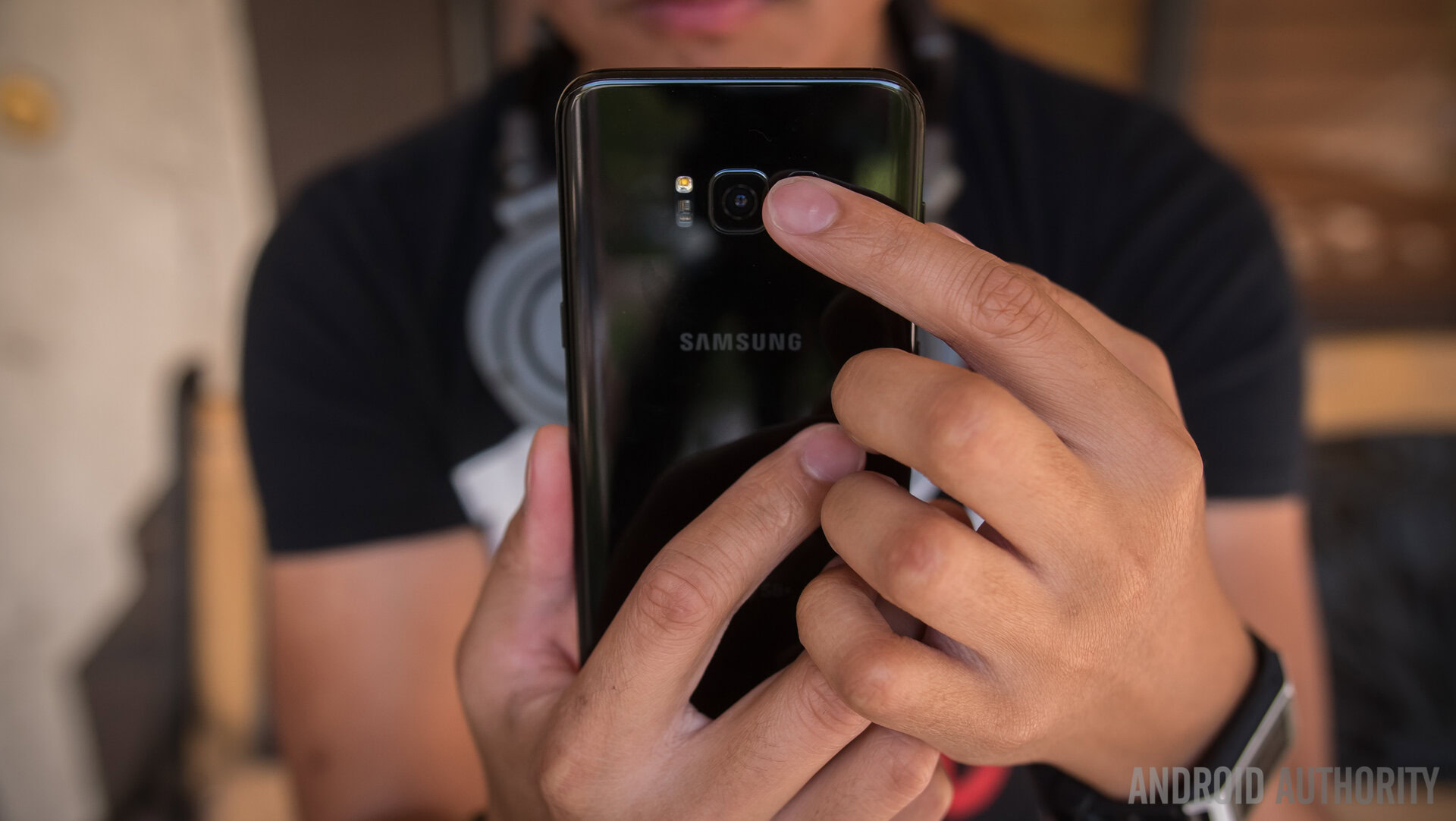
The back is where Samsung has made arguably the worst design decision on the Galaxy S8; removing the home button means Samsung had to find a place for the fingerprint sensor and they chose to combine it with the heart rate monitor next to the rear camera. While other OEMs have chosen to put fingerprint sensors in the center of the device, Samsung’s decision means it can have its logo right underneath the camera, but as a result, the fingerprint sensor is cumbersome to use.
The position doesn’t feel natural and on the regular Galaxy S8, it’s a stretch with large hands, while on the Galaxy S8 Plus, it’s awkward unless you have very large hands. As you’ll often be fumbling blindly to find the fingerprint sensor, you may end up with fingerprints on the camera lens itself, so Samsung has included a reminder when you launch the camera to wipe it down.
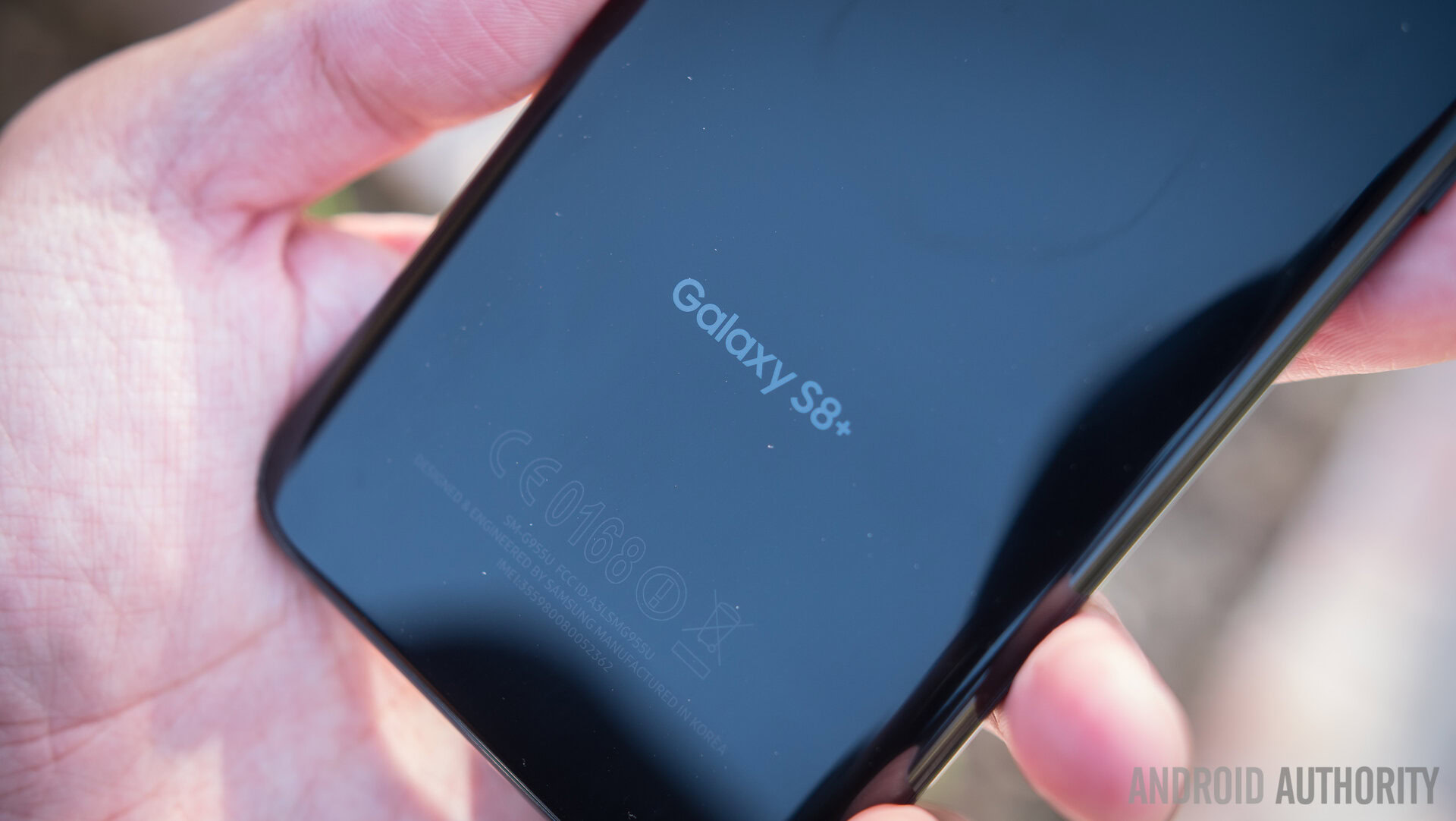
The location of the fingerprint sensor does render a very good sensor near-useless
Being forward-thinking and attempting to redefine the meaning of a big phone isn’t without its challenges, and while Samsung has made an excellent attempt, the location of the fingerprint sensor does render a very good sensor near-useless. However, thanks to other biometric options, it’s a small compromise for what is one of the best-designed smartphones ever made.
Thanks to a taller screen, the removal of the home button, and bezels that are slimmer than ever, Samsung has managed to put a bigger screen in a footprint that’s barely bigger than last year. Samsung is known for making stunning smartphones and the Galaxy S8 is its best yet, ushering in a new era of smartphone design and laying down a marker for Samsung’s rivals.
Display
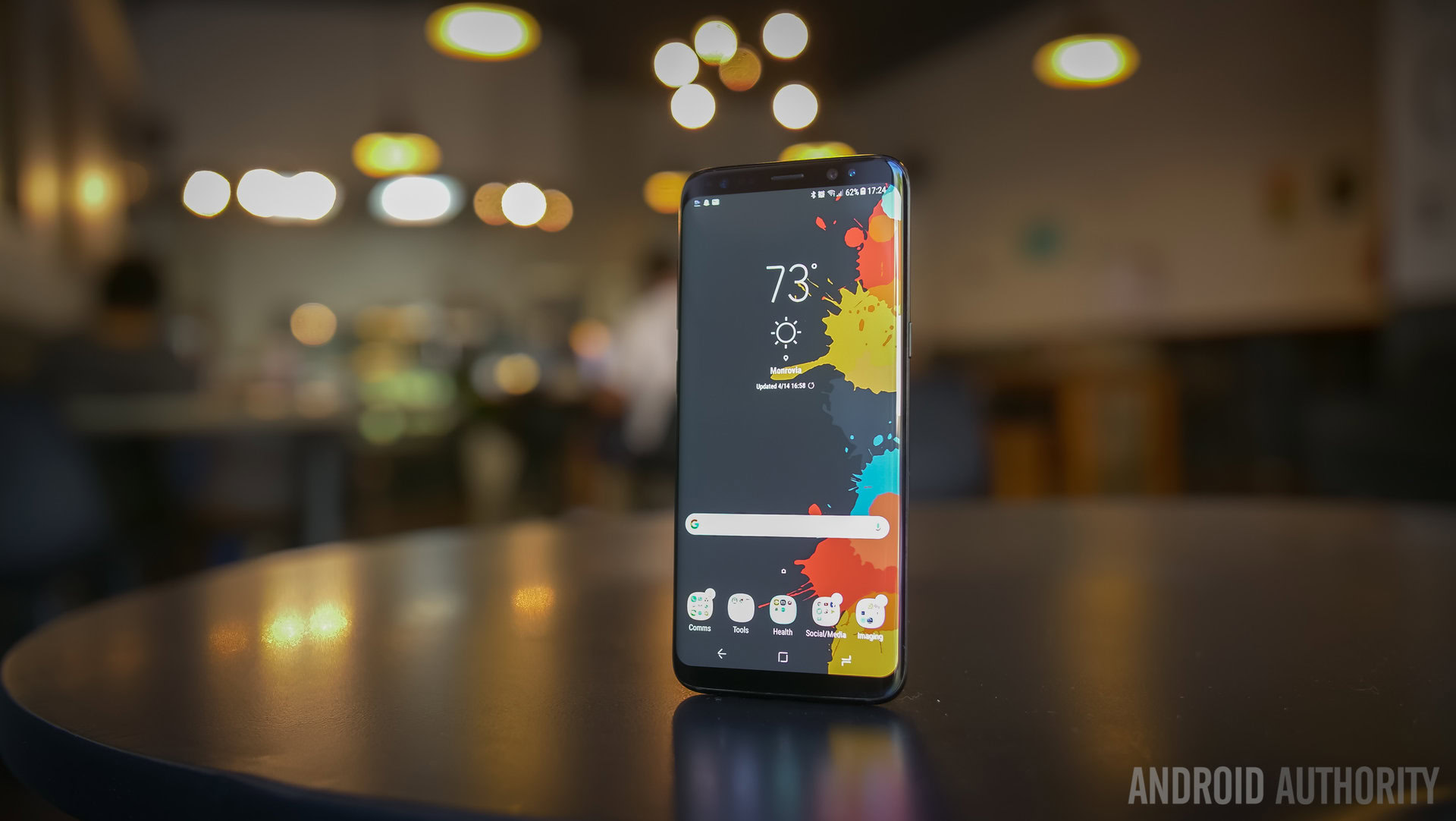
All of this leads to what we’ve come to expect from Samsung displays – an extremely vivid Super AMOLED display that punches colors harder than before and is a joy to use. Rated as one of the first HDR-capable smartphones, the Galaxy S8 screen ups the brightness and color saturation of the screen when viewing content like YouTube and apps that support HDR, such as Netflix. It’s a noticeable improvement when switching in and out of the app, but it means that the Galaxy S8 offers the best mobile entertainment experience on a smartphone to date.
The 18.5:9 aspect ratio means Samsung has managed to pack more pixels into its display, with the Galaxy S8 and S8 Plus both offering displays at 2960 x 1440 pixels. On the Galaxy S8, this translates to a pixel density of 570 pixels per inch, while on the Galaxy S8 Plus this is a little lower at 529 pixels per inch.
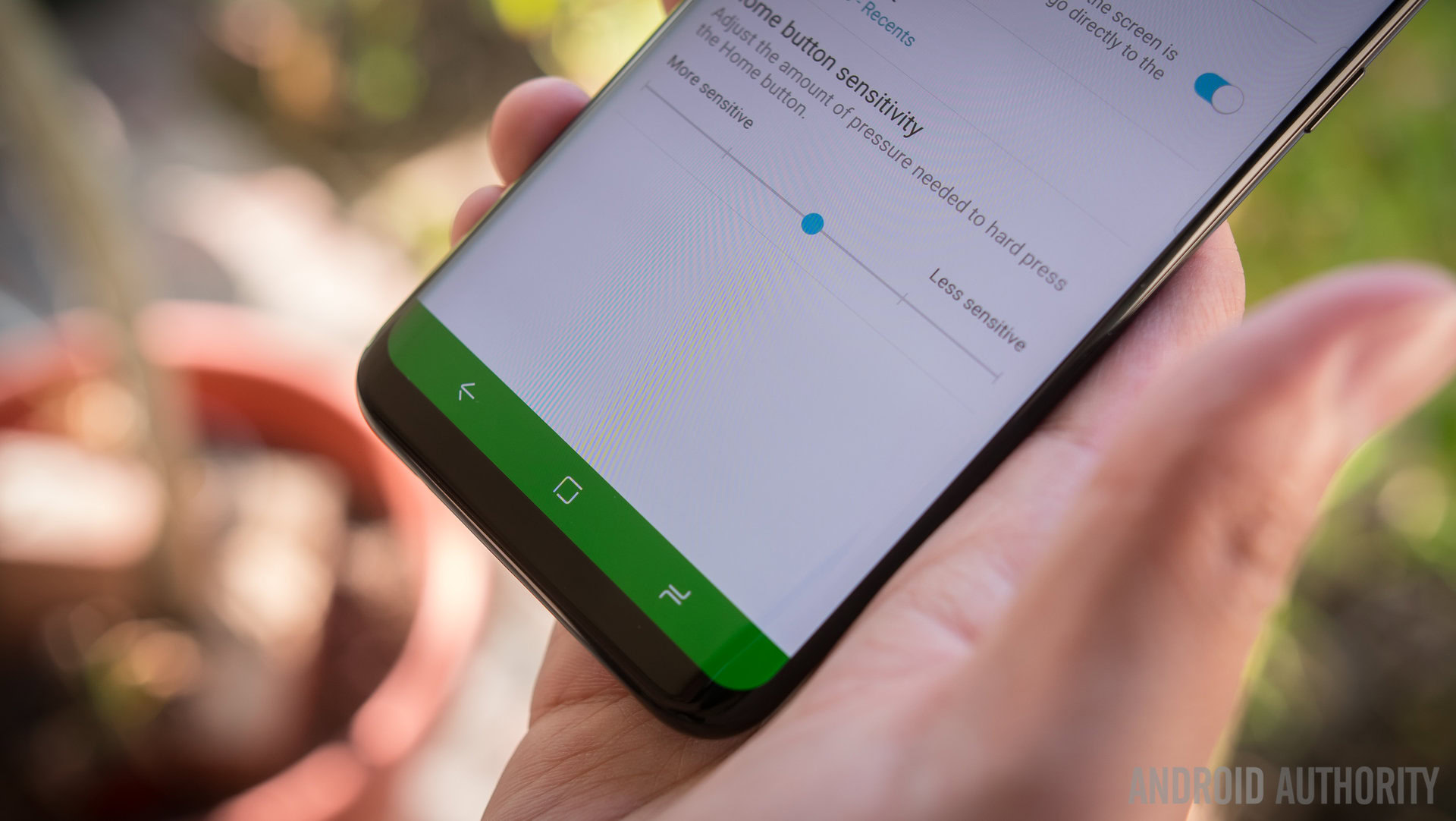
The additional pixels mean a taller display overall, but there is some pillar-boxing when watching widescreen content so you’ll have black bars on the sides. You might find the bars distracting for most media content, but you can force apps to full screen mode either through the display settings menu or by tapping the icon in the recent apps menu.
Out of the box, both phones come with the display scaled down to Full HD+, but you can tweak this and things like color saturation in the display settings.
Samsung has found a way to preserve the original unlocking experience of previous Galaxy devices
The removal of the home button means a switch to soft keys, but Samsung has included a pressure sensitive area near the bottom of the display which vibrates when pressed hard enough and can be used for unlocking the phone when it’s asleep. Samsung has found a way to preserve the original unlocking experience of previous Galaxy devices, but the soft keys work well enough that you may almost forget the pressure sensitive button exists. On-screen keys allow you to swap the position of the “recent apps” and “back” keys, but unlike with other manufacturers, there’s no option to add an additional key for the notification menu.
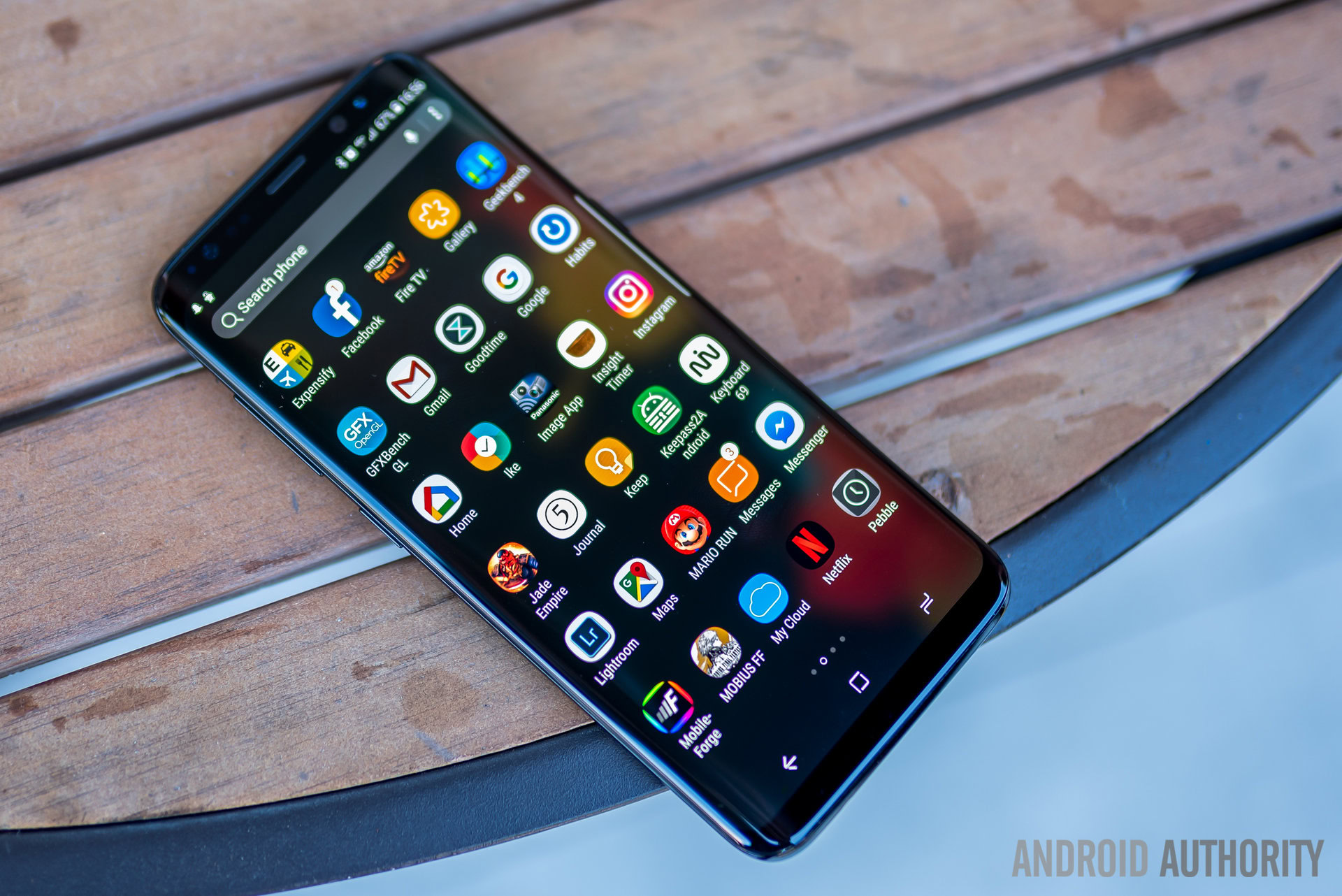
Running the Galaxy S8 display through our testing, we found the screen has a max brightness of 373 nits with auto brightness turned off and 515 nits with it turned on. During sunlight we found a visible punch in the brightness and although the display isn’t technically the brightest, it is definitely pleasing to the eye. With a color accuracy of 7180 Kelvin, the Galaxy S8 doesn’t have the most accurate display in its default out-of-the-box state, and has a warm tone, but with all of these effects turned off, the display is the closest we’ve come to the ideal temperature of 6500K with a temperature of 6440K.
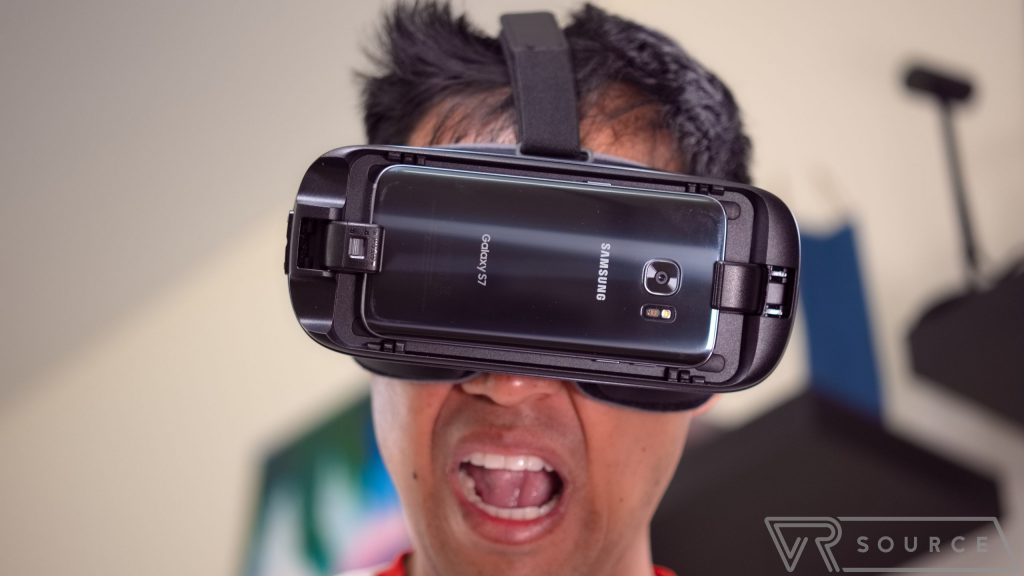
Overall, the addition of so much real estate is a more than welcome trade-off to Samsung removing the home button and much of the experience remains the same otherwise, including the Edge UX and Always On Display, which have a couple of actionable additions. Past Samsung devices have always sported great looking displays, but the Galaxy S8 is in a class of its own and offers one of the most immersive experiences on a smartphone to-date.
Performance
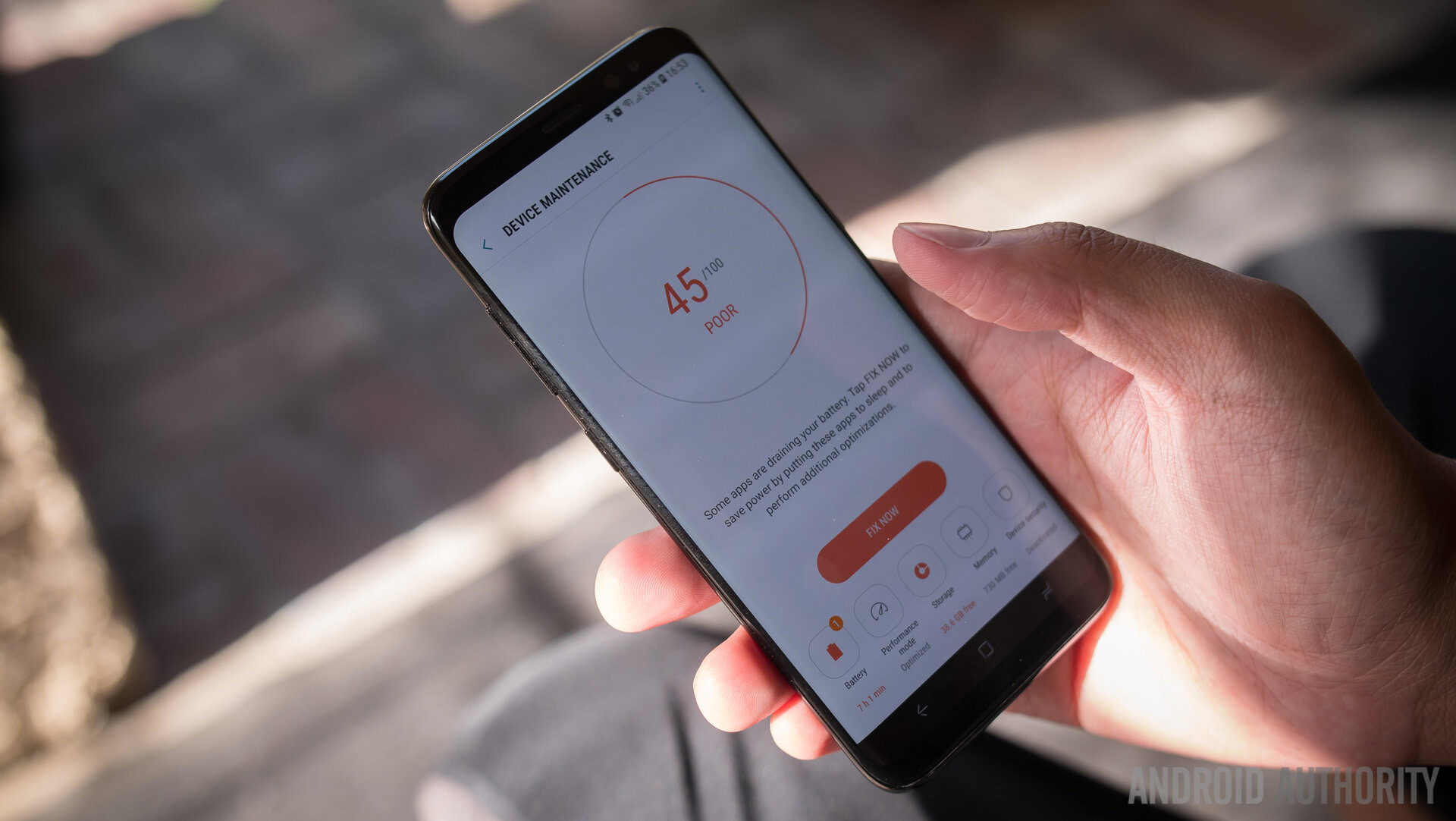
As the latest Samsung flagship, you can expect the latest processing package and the Galaxy S8 doesn’t fail to deliver. Depending on your market, you can either expect the latest Exynos 10nm chipset or the Snapdragon 835, both coupled with 4 GB of RAM and 64 GB of on-board storage, which is expandable via a microSD card. The Exynos version comes with the Mali-G71 MP8 GPU while the Snapdragon 835 has the Adreno 540 GPU.
Related: Let’s give it to Samsung for making 64 GB standard in the Galaxy S8
As you might expect, there are no performance concerns with the processing stack that powers the Galaxy S8. During our Samsung Galaxy S8 review process we’ve noticed no issues with performance in applications or while gaming. When running Super Mario Run and Jade Empire – which are both heavy mobile games – there were no issues with dropped frames or lag.
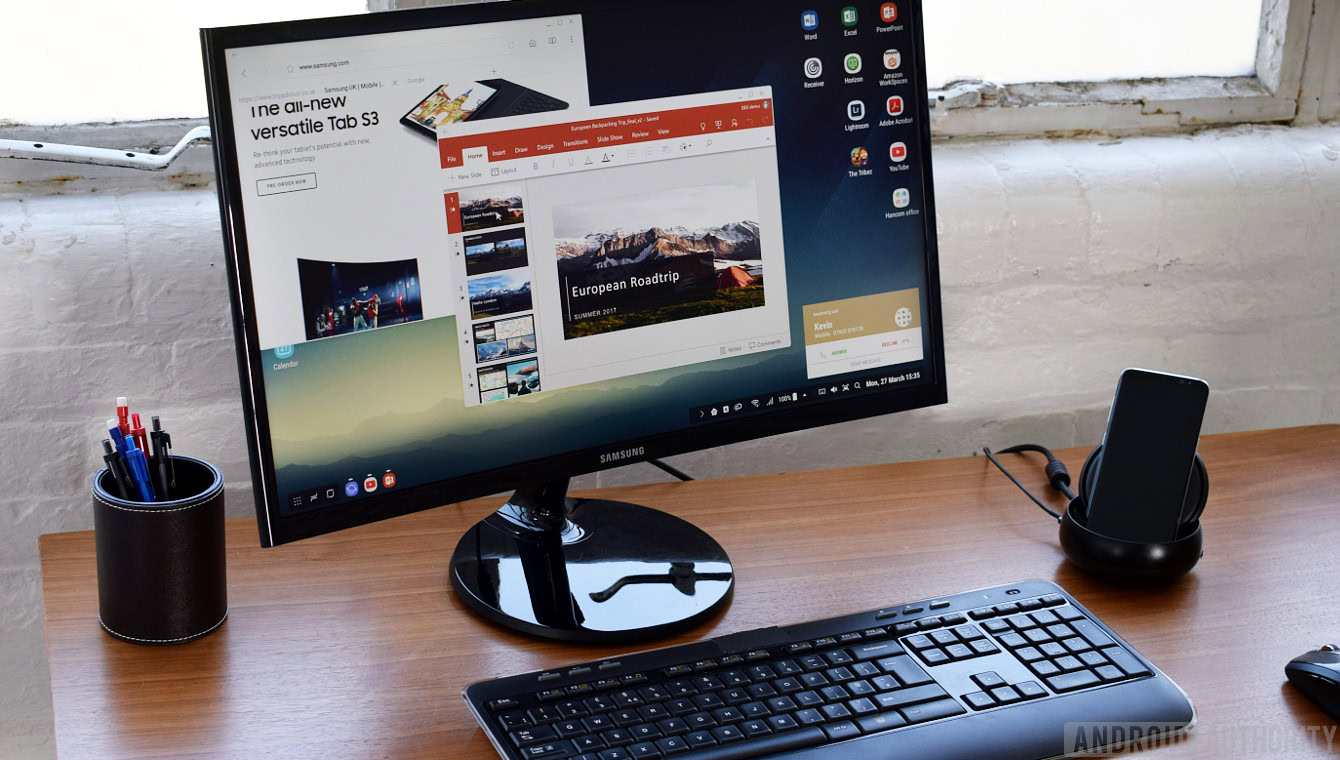
The Galaxy S8 also powers the DeX, Samsung’s new docking accessory that allows you to turn your Galaxy S8 into a full desktop computer. It’s testament to the processing power of both chipsets that they’re able to deliver a full desktop experience with little more than a couple of small hiccups and ever so slight latency when recognizing the input from a Bluetooth keyboard and mouse.

When the iris scanner can see your eyes unobstructed, it is lightning fast
The only noticeable performance issue I personally experienced is with the iris recognition which, like on the Galaxy Note 7, fails to work properly if you wear glasses. Samsung warns you to remove glasses or contact lenses when setting up the iris recognition, but this means you’ll have to either look over the top of your glasses or lift them up for iris recognition to be useful. Josh hasn’t had any issues with this, so it might be an issue with my handset and when the iris scanner can see your eyes unobstructed, it is lightning fast.
Hardware
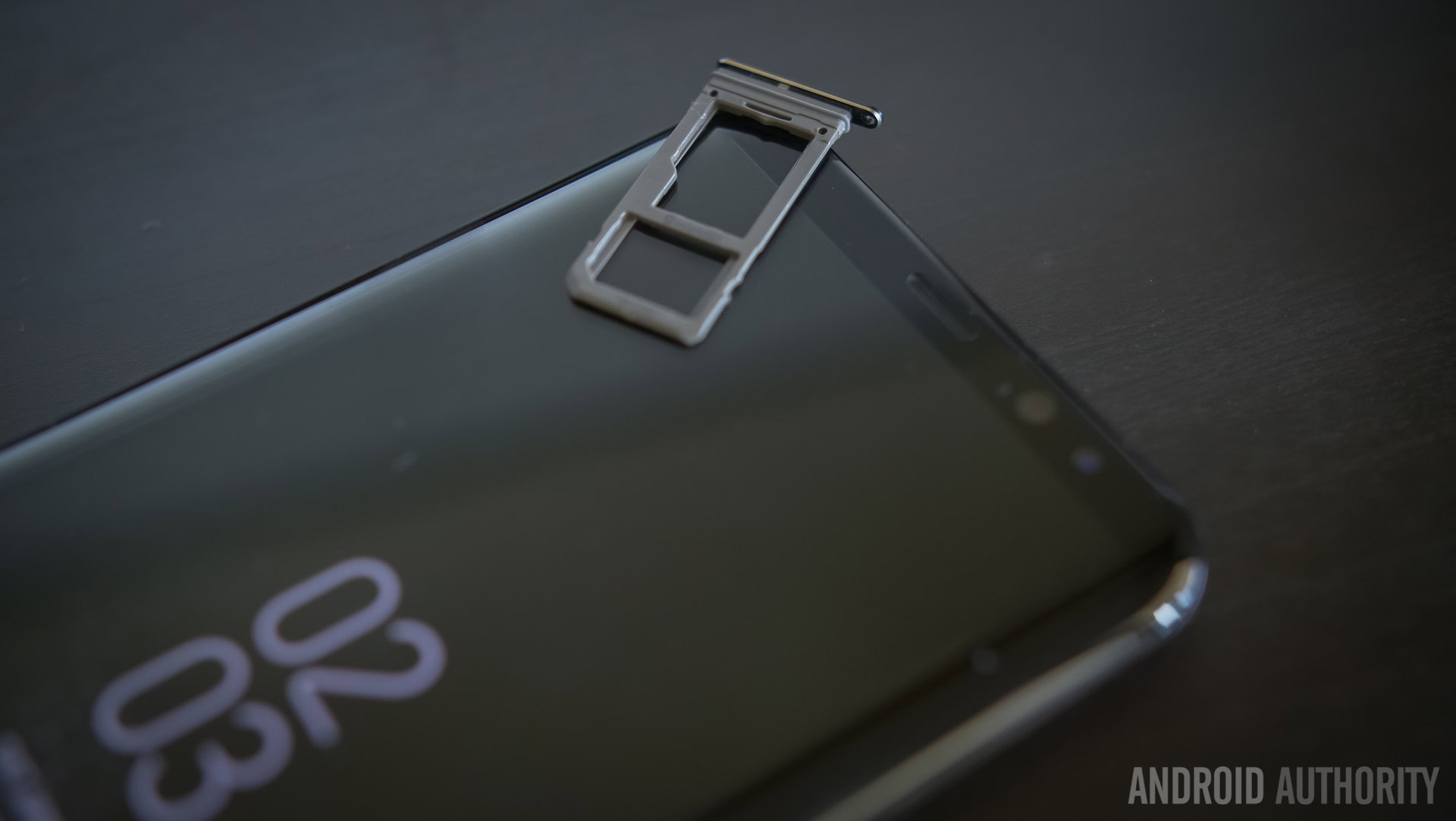
As you might expect, the Galaxy S8 and Galaxy S8 Plus come equipped with a heavy hardware stack which includes expandable storage, a 32-bit audio DAC, dual-band Wi-Fi, and a plethora of connectivity options.
You can connect to two Bluetooth speakers or headphones at the same time and play audio through both simultaneously
The Galaxy S8 is also one of the first phones to support Bluetooth 5, which brings with it a much longer range and the ability to have an active connection with two different devices. In the real world, this means you can connect to two Bluetooth speakers or a speaker and headset at the same time and play audio through both simultaneously.
Right next to the USB Type-C port on the bottom of the phone is the single bottom-firing speaker and the headphone jack. The loudspeaker has the same issues that are inherent to its design, mainly a tinny sound, and overall, it’s decent at best. Samsung’s acquisition of Harman Kardon should eventually result in much better audio, but it likely came too late for the speakers on the Galaxy S8.
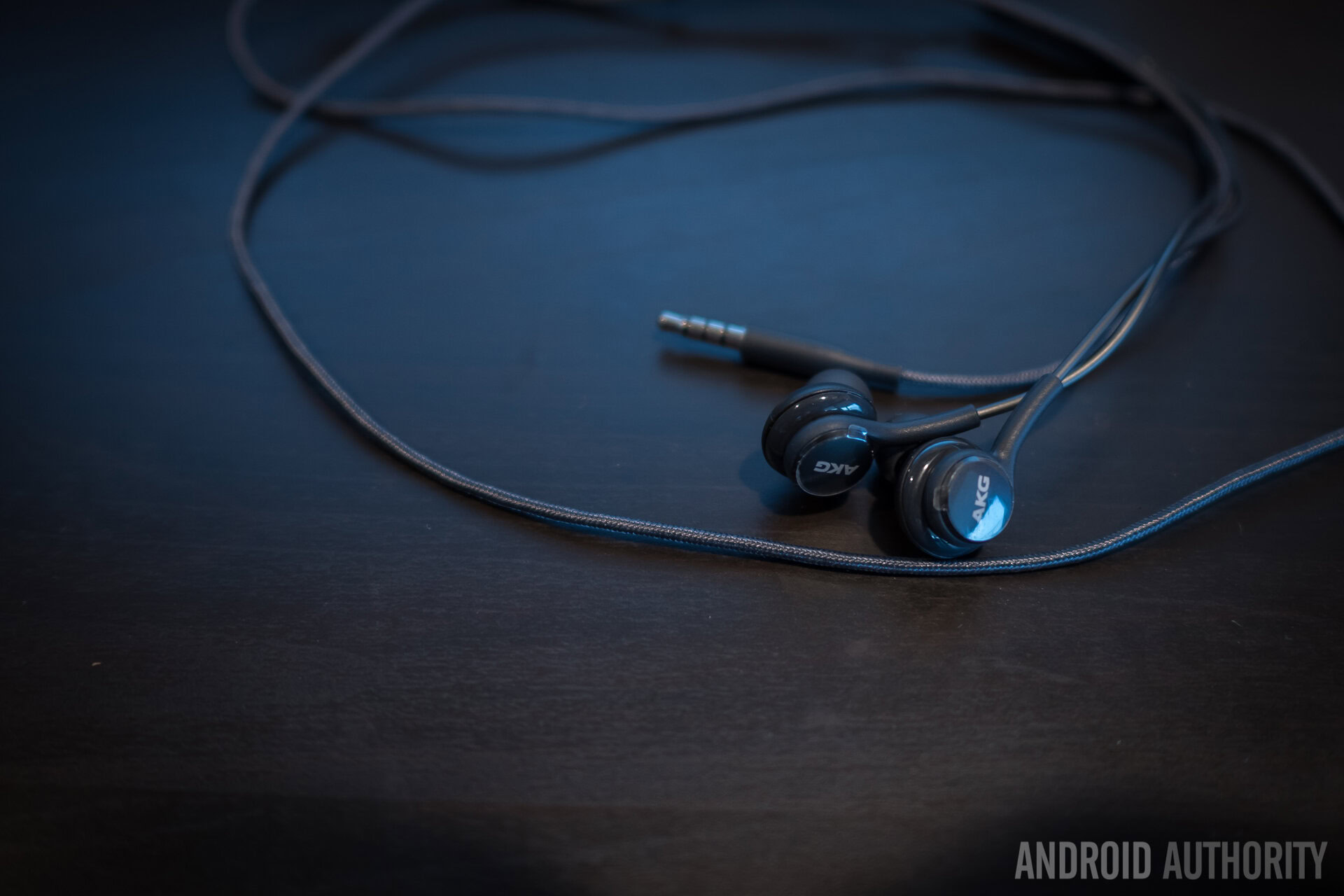
However, with the headphone jack, Samsung has taken a different approach by focusing on headphones instead of including a third-party DAC or built-in amp. Instead, they’ve included a pair of high-quality earphones made by AKG, and while we have a full review of these headphones coming soon, we can say they are significantly better than the headphones included with any other phones.
The headphones are surprisingly “bassy” for small earphones and feature a premium feeling design that includes a fabric cable and in-line controls. Diving deep into the sound settings, there’s a bunch of equalizer toggles that can be used to cater the audio experience to your preferences. There’s an Adapt Sound tutorial that helps you tune the output to your own ears and the result is a headphone experience that manages to be surprisingly deep for the average user. Given what’s happened in a short-space of time, we expect Samsung’s acquisition of Harman Kardon to result in a vastly improved audio experience on future flagships.
Battery life
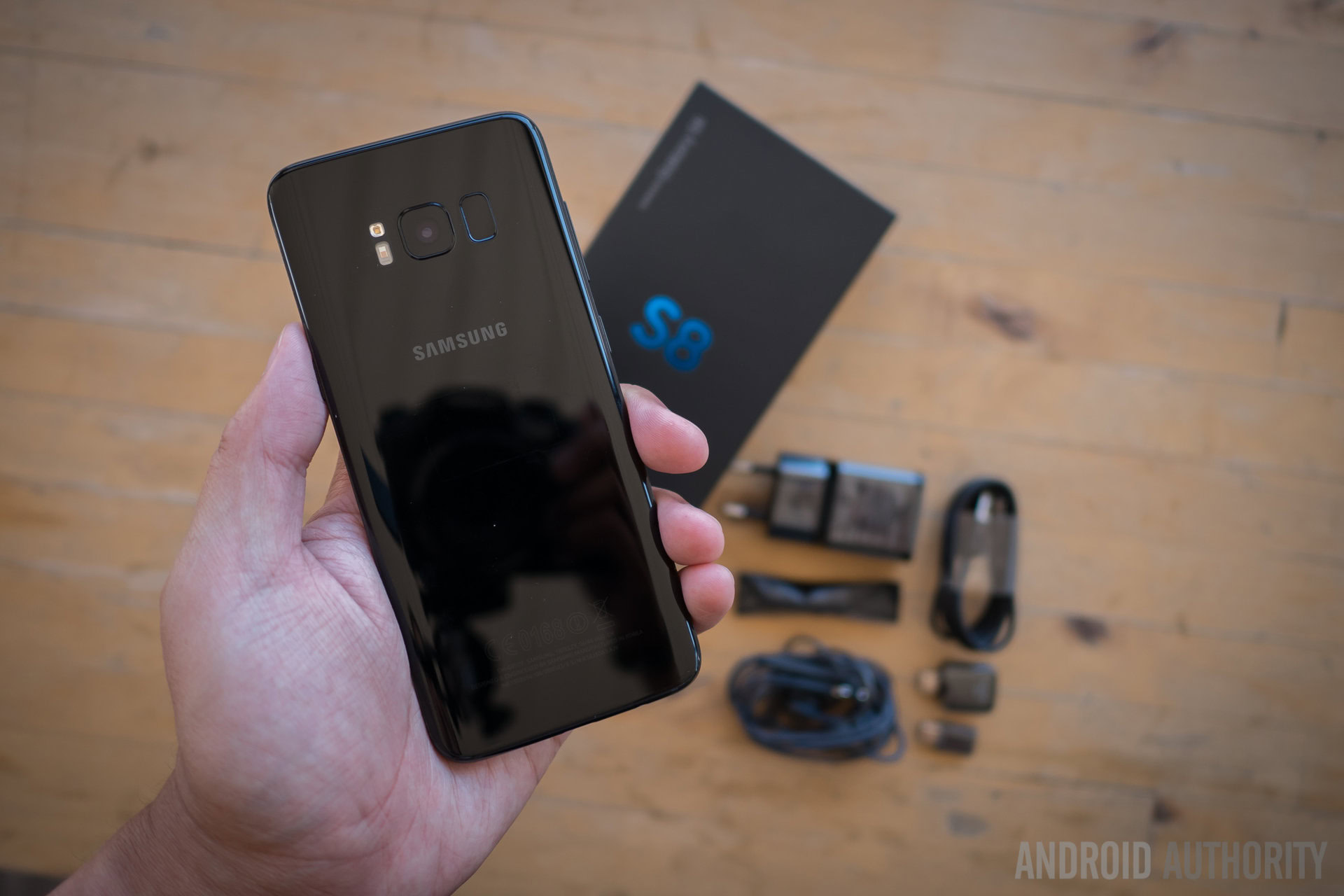
The biggest issue facing Samsung with the Galaxy S8 is the fear that still resides from the Galaxy Note 7’s batteries catching fire spontaneously. Personally, I think the company has played it a little safe with the battery capacity inside its new flagships, in a bid to prevent any issues with the battery.
Rather than stretch the boundaries like they did with the Galaxy Note 7, Samsung has opted for the rather safe capacities of 3,000 mAh for the Galaxy S8 and 3,500 mAh for the Galaxy S8 Plus. This means the Galaxy S8 battery is the same size as the Galaxy S7, while the Galaxy S8 Plus is slightly smaller than the 3,600 mAh battery found inside the Galaxy S7 Edge.
The Galaxy S8 battery life has proven to be on par with most flagships, but not spectacular
Over the past two weeks, the Galaxy S8 battery life has proven to be on par with most flagships, but not spectacular. During an average 18-hour work day, the Galaxy S8 offered around 4 hours of screen-on-time for Josh, and on occasion, this stretched to five hours. In comparison, the battery life for me offered around 3.5 to 4 hours of screen on time from a 14- to 18-hour work day. TouchWiz gives you lots of different power saving features and combined with the Super AMOLED display, you can stretch out the battery life even further.
As mentioned before, our time with the Galaxy S8 Plus has been limited, so we’re not able to comment on the battery life yet. However, we’ll be publishing the results of our battery testing for both phones in the coming week. From real world usage with the regular Galaxy S8, it’s clear that the battery life will vary according to your usage, but we seldom had to top the phone up before bedtime.
Camera
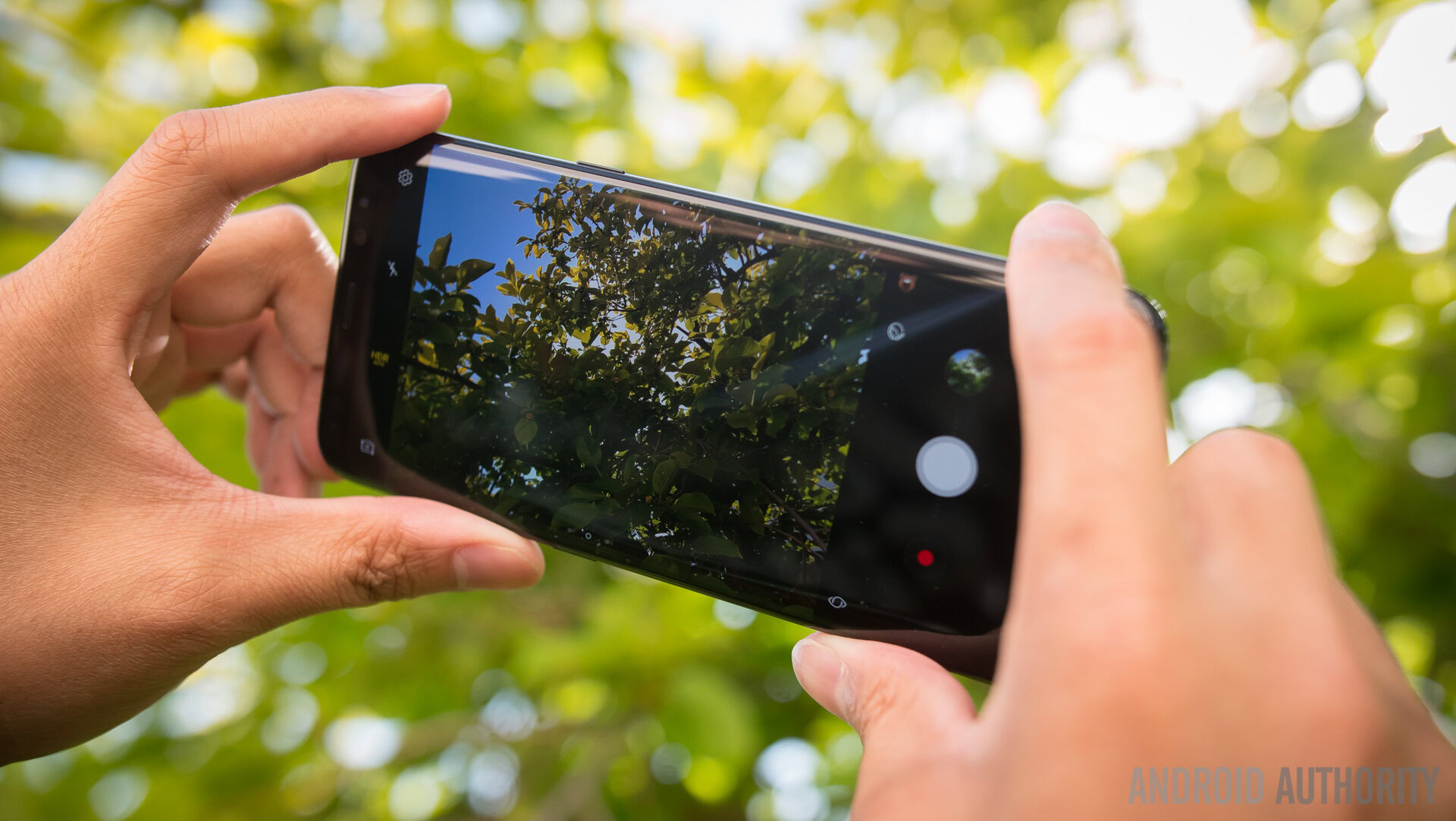
Samsung has refined its camera over the past few generations of its phones to produce what is arguably the all around best smartphone camera on the market. The Galaxy S8 camera may not be heavily changed from the Note 7, and even the Galaxy S7 Edge before it, but enhancements in the overall picture taking experience mean Samsung’s legacy of high quality photography continues.
The big changes in the cameras come at the front, where Samsung has included an 8 MP shooter with a Smart Autofocus system. Autofocus is not something found too often on front-facing cameras and selfies benefit from the higher megapixel count, resulting in good photos in most lighting conditions. In low light, the pictures lose some sharpness as the shutter requires more time, but this is expected, especially from a camera that lacks image stabilization.
The main camera is a 12 MP shooter with large dual pixels, f/1.7 aperture, optical image stabilization, phase detection autofocus, and an LED flash. The interface is largely like before, prioritizing swipes and certain gestures to keep shooting simple and as easy to use in one-hand as possible. There are no new modes in the camera, though there is the addition of 1080p recording at 60 frames per seconds for smooth video recording. Video recording also sees the addition of manual controls in the Pro mode, including manual focus for finer control over the focus of your videos.
Galaxy S8 camera samples:
Samsung touts that the camera has multi-frame processing, which means it takes multiple shots of the same image and puts them together to get the best colors and detail from a scene. This aside, the experience and quality are almost identical to the Galaxy Note 7 and Galaxy S7, with images featuring high amounts of saturation and detail in all but the very darkest of conditions. The camera isn’t the most accurate – Samsung devices never produce the most accurate photos – but the bump in saturation and detail mean the photos look more appealing to the eye compared to other phones.
The only real difference in the camera UI is the addition of a small eye icon in the bottom left of the viewfinder, which fires up the biggest addition to the camera, and the phone itself: Bixby.
Software

Samsung’s take on the mobile assistant comes in the form of Bixby, which can be found throughout the phone in a lot of different ways. Bixby isn’t the first time Samsung has attempted to offer a virtual assistant, after all the company did launch the infamous S Voice on the Galaxy S3. Despite much hype, it ended up being a poor imitation of Apple’s Siri – and more recently, Google Now – and S-Voice was heavily criticized, quickly forgotten, and slowly it got relegated to the status of one of the first apps you disable when you get your phone.
Samsung is hoping that Bixby doesn’t suffer the same fate as S Voice
Samsung is hoping that Bixby doesn’t suffer the same fate and seemingly recognized its weakness with S Voice through the acquisition of Viv, an AI platform that was developed by none other than the makers of Siri. That said, Bixby does not include Viv technology right now, though that will likely change in future iterations.
Samsung’s assistant focuses on three key areas: Vision, Voice and Home.
We’ll start with Bixby Vision, which manifests itself in the camera through the little eye icon. Tapping this fires up Bixby Vision, which brings augmented reality to the camera in a bid to provide information in real time, based on the objects in the viewfinder. The premise of Vision is that it’s meant to be able to deliver reviews on restaurants, shopping links for items, and related images all in real time. While our initial demo looked impressive, Bixby Vision is in a very early stage.
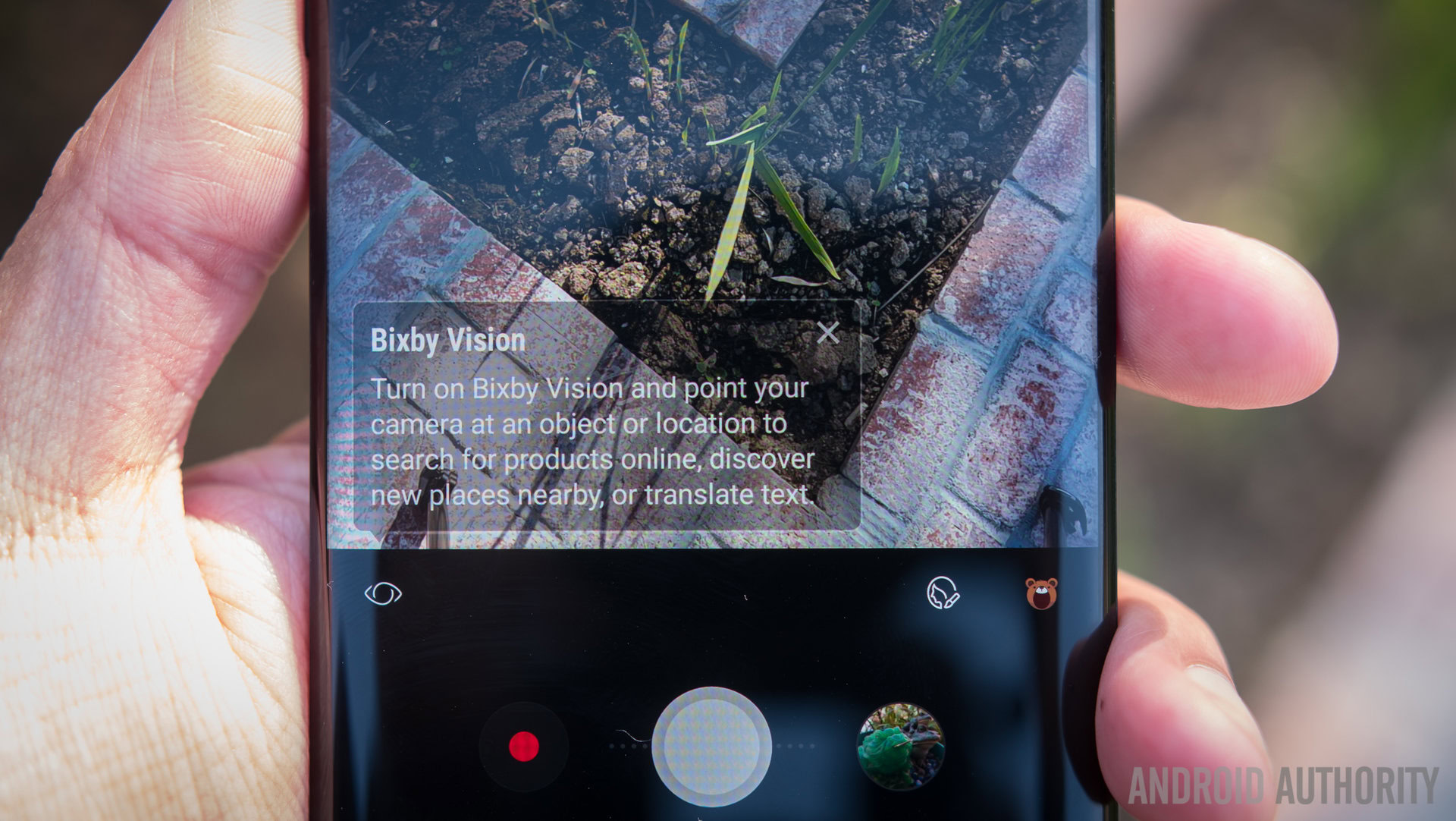
For now, Bixby Vision does do a great job at looking up reviews of wine
Scanning a restaurant name brings up no related info, and scanning a simple water bottle doesn’t bring up any shopping links. Samsung has teamed up with various apps and services to have a wider range of data and while most partnerships seem to be in early stages, Vision does do a great job at looking up reviews of wine. Samsung has partnered with Vivino to bring wine reviews, average selling price, and ratings directly to Vision, and it works as well as the regular Vivino app does.
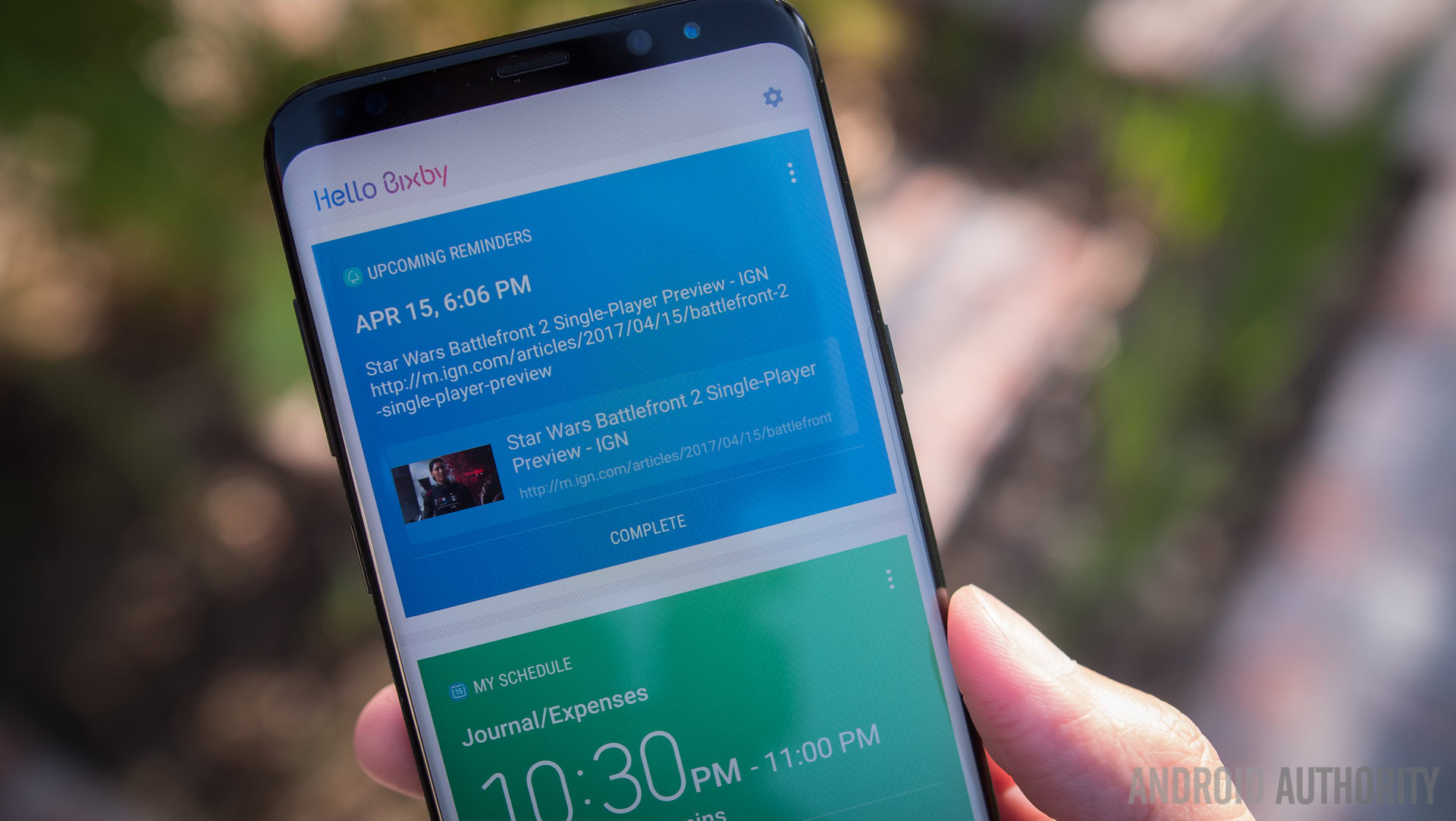
On the left of the Galaxy S8, you’ve got a dedicated shortcut button to launch Bixby Home, which aims to integrate various apps and services into a single screen in a similar way to Google Assistant. A new reminders app means you can set a reminder from within an application using the share menu and then it appears as a reminder within Bixby Home. While it works well enough overall, you do need to use all of Samsung’s apps that feed into it, rather than say, Google’s native Android apps. For some users, this won’t be an issue but for others, a reliance on Samsung’s apps over others could be a deal breaker, especially as Google’s own apps feed into Assistant which is also present on the Galaxy S8.
For now, Home is the most interesting part of Bixby, at least until Bixby Voice launches later in the year. Voice is expected to offer a lot of the conversational tone, that Google offers with its Assistant, but the biggest issue for Samsung is how long it will take for Bixby Voice to launch. We expected Bixby Voice to be available around the time of the Galaxy S8’s launch later this week, but instead, it’s likely to only be available in South Korea, with an US launch scheduled for later this spring.
Samsung has shown with Samsung Pay that it’s not the fastest at rolling features out to new markets, and with places like Germany not expected to get Bixby Voice until the end of the year, it’s likely that future devices will benefit more from Bixby Voice than the Galaxy S8 and Galaxy S8 Plus. Like with all assistants, Samsung will improve Bixby and it will get better with time, but right now, it’s lacking features that make it truly outstanding.
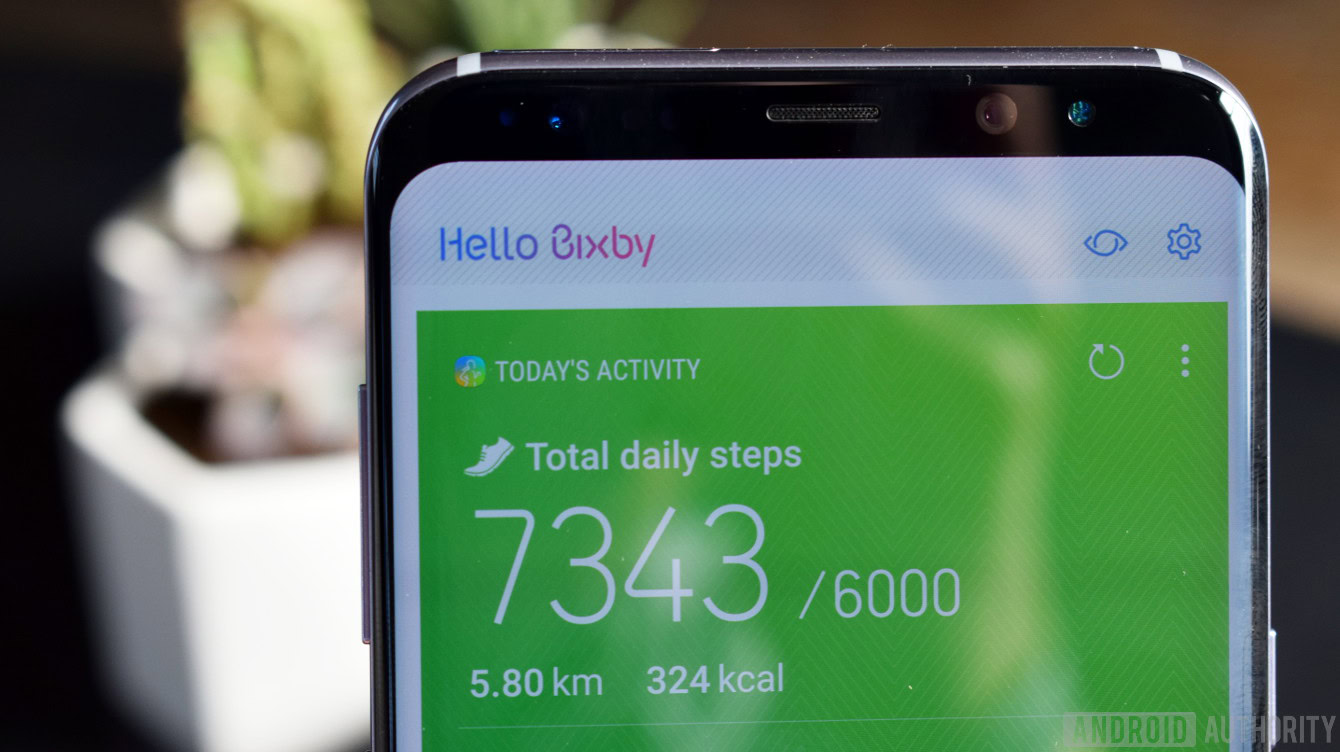
We wish the Bixby button could be customizable so you could launch other apps or services
That said, Samsung clearly recognizes that Bixby will take time to mature into the platform it has the potential to be and it’s likely that giving users the choice of Google Assistant is a way to mitigate this. Josh and I both like having a dedicated button to launch Bixby Home, rather than just a home screen, but we do wish it could be customizable so you could launch other apps or services, like Google Assistant, instead. Just days ahead of the Galaxy S8’s launch, Samsung blocked an unofficial method for remapping the button to other features.
Bixby aside, the rest of the Galaxy S8 software is mostly identical to previous years with a little refinement for the various Galaxy S8 features that we’ve already mentioned. The experience on the Galaxy S8 feels familiar, as Samsung has been working hard to give you their version of services that we already somewhat have.
Unlike previous years where a multitude of tutorials became the standard, the Galaxy S8 instead allows you to dive into the settings menu and learn everything the phone can do at your own pace. Samsung’s Nougat interface is one of the better-looking ones, and the plethora of features means there’s an abundance of customization options. The Galaxy S8 proves that Samsung has tried to do everything at once, and while there may be some redundancy, the addition of so many features offers more customization than what’s found on most devices.
Galaxy S8 and S8 Plus specifications
| Samsung Galaxy S8 | Samsung Galaxy S8+ | |
|---|---|---|
Display | Samsung Galaxy S8 5.8-inch Quad HD+ Super AMOLED 2960 x 1440 resolution 570 ppi 18.5:9 aspect ratio | Samsung Galaxy S8+ 6.2-inch Quad HD+ Super AMOLED 2960 x 1440 resolution 529 ppi 18.5:9 aspect ratio |
Processor | Samsung Galaxy S8 U.S.: 64-bit octa-core (2.35GHz Quad + 1.9GHz Quad) Qualcomm Snapdragon 835, 10 nm process Global: 64-bit octa-core (2.3GHz Quad + 1.7GHz Quad) Samsung Exynos 8895, 10 nm process | Samsung Galaxy S8+ U.S.: 64-bit octa-core (2.35GHz Quad + 1.9GHz Quad) Qualcomm Snapdragon 835, 10 nm process Global: 64-bit octa-core (2.3GHz Quad + 1.7GHz Quad) Samsung Exynos 8895, 10 nm process |
RAM | Samsung Galaxy S8 4 GB LPDDR4 | Samsung Galaxy S8+ 4 GB LPDDR4 |
Storage | Samsung Galaxy S8 64 GB USF 2.1 | Samsung Galaxy S8+ 64 GB USF 2.1 |
MicroSD | Samsung Galaxy S8 Yes, up to 256 GB | Samsung Galaxy S8+ Yes, up to 256 GB |
Cameras | Samsung Galaxy S8 Rear: 12 MP Dual Pixel sensor, f/1.7 aperture, OIS Front: 8 MP sensor, f/1.7 aperture | Samsung Galaxy S8+ Rear: 12 MP Dual Pixel sensor, f/1.7 aperture, OIS Front: 8 MP sensor, f/1.7 aperture |
Battery | Samsung Galaxy S8 3,000 mAh Fast charging | Samsung Galaxy S8+ 3,500 mAh Fast charging |
Wireless charging | Samsung Galaxy S8 Yes, Qi and PMA | Samsung Galaxy S8+ Yes, Qi and PMA |
Water resistance | Samsung Galaxy S8 IP68 dust and water resistance | Samsung Galaxy S8+ IP68 dust and water resistance |
Connectivity | Samsung Galaxy S8 Wi-Fi 802.11 a/b/g/n/ac (2.4/5 GHz), VHT80 MU-MIMO,1024QAM Bluetooth 5.0 (LE up to 2 Mbps) ANT+ USB Type-C 3.5 mm headphone jack NFC Location (GPS, Galileo, Glonass, BeiDou) | Samsung Galaxy S8+ Wi-Fi 802.11 a/b/g/n/ac (2.4/5 GHz), VHT80 MU-MIMO,1024QAM Bluetooth 5.0 (LE up to 2 Mbps) ANT+ USB Type-C 3.5 mm headphone jack NFC Location (GPS, Galileo, Glonass, BeiDou) |
SIM | Samsung Galaxy S8 Nano SIM | Samsung Galaxy S8+ Nano SIM |
Software | Samsung Galaxy S8 Android 7.0 Nougat | Samsung Galaxy S8+ Android 7.0 Nougat |
Dimensions and weight | Samsung Galaxy S8 148.9 x 68.1 x 8mm 155 g | Samsung Galaxy S8+ 159.5 x 73.4 x 8.1 mm 173 g |
Galaxy S8 photos
Samsung Galaxy S8 review – price & final thoughts

The Galaxy S8 and Galaxy S8 Plus continue Samsung’s recent penchant of combining outstanding smartphone design with an excellent display to create an all-around fantastic experience. The switch to the taller display has allowed Samsung to cram even more screen real estate into its new smartphones and in doing so, the company is setting the new standard for big-screen devices. Think back to what a big screen phone meant a couple of years ago and compare it to the Galaxy S8 and it’s clear that the future is much brighter, and we’re now closer than ever to phone that is all display.
With the Galaxy S7 and S7 Edge both proving to be excellent smartphones, Samsung sought to refine its smartphone experience further and achieved that, albeit with some trade-offs. The biggest of these is that a major selling feature – Bixby – is in its very early stages and, as a result, it’s not as useful as Samsung led us to believe. That said however, the Galaxy S8 is arguably the best phone for most users, but it might not be the best phone for users who want specific features.
For the all-around big-screen experience, Samsung has knocked it out of the park and while the likes of LG and HUAWEI definitely come close, the design of the Galaxy S8 means it stands tall above the competition. Thus concludes our Samsung Galaxy S8 Plus and Samsung Galaxy S8 review. What do you think of Samsung’s latest S series devices? Let us know down in the comments.
Related coverage
The truth about Bluetooth 5 – Gary explains
Samsung DeX hands-on and reactions
Galaxy S7 Edge revisited: Is it still worth it?
What do you think of the Galaxy S8 and Galaxy S8 Plus, and which of these would you buy? Personally, I find the smaller Galaxy S8 much more comfortable in the hand, but what do you think? Hit up the comments below!